| Reviews & Columns |
|
Reviews DVD TV on DVD Blu-ray 4K UHD International DVDs In Theaters Reviews by Studio Video Games Features Collector Series DVDs Easter Egg Database Interviews DVD Talk Radio Feature Articles Columns Anime Talk DVD Savant Horror DVDs The M.O.D. Squad Art House HD Talk Silent DVD
|
DVD Talk Forum |
|
|
| Resources |
|
DVD Price Search Customer Service #'s RCE Info Links |
|
Columns
|
|
|
History in 3D
"History in 3D" is a boxed set comprised of 3 discs which are also available separately.
Content:The first disc is "WWII in 3D", which is a short (44 minutes) but very fascinating look at 3D still and motion picture photography during World War II. Narrated by Tom Wilkinson, he tells how the Nazis used 3D for many of their propaganda photos. Adolph Hitler had commissioned photographer Heinrich Hoffmann to carefully photograph him in what the narrator calls "a God-like stature".
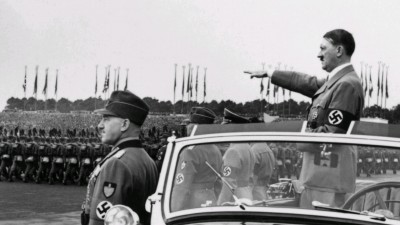
These photos are in black and white, but their depth rivals the quality of anything shot in 3D recently. As those who have been familiar with 3D for a long time know, an early way of viewing 3D pictures was through a "stereoscope", a viewer with lenses that could view cards with the left and right images printed next to each other. This was actually a rather popular form of home entertainment before the invention of television. Hitler also commissioned German publisher Otto Schonstein, who had previously printed some of these stereoscopic cards, to print books of the photos. One book is shown with pockets inside its front cover holding a foldable stereoscopic viewer and a set of 3D photo cards.
3D footage of a number of historians giving their thoughts on the photos and footage is interspersed throughout. The primary guest speakers include Martin KA Morgan, Director of Research and Historian in Residence at the National WWII Museum from 2000 to 2008, Alex Kershaw, author of "The Longest Winter" (who speaks positioned next to an outdoor cannon pointed away from the camera), 3D historian David Starkman. Some footage is included of them viewing the photos being discussed on flatscreen monitors with the brand names covered with black tape, but the pictures on them are clearly overlayed in post-production and shots of the back of the monitors show no power or input cords at all! Oops.
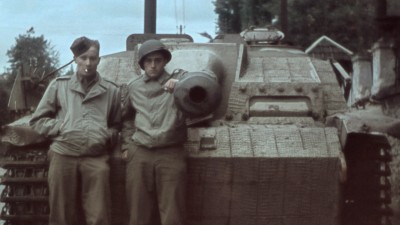
The photos are primarily panned across while described by the narrator. There is also footage of a German training film shot in black and white 3D with some animation, showing soldiers how to operate an 8mm flak gun. Only a few seconds' worth of this footage is shown here however, and is obviously horizontally cropped to fill the 16x9 frame. There is also a few seconds of another film showing how to properly project the 3D footage, which would have been fascinating to see in its entirety. (A point is made about how many 3D films of this type were made, but these were the only ones that survive today.) Other 2D film footage from the era is also included throughout, also cropped and in 3D appearing to be projected deeper inside the screen than a normal 2D image would appear.
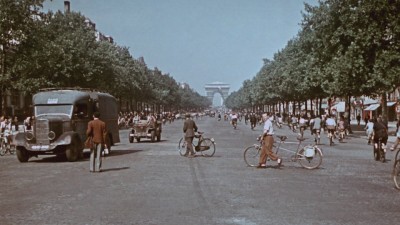
Color 3D photos of the liberation of Paris are also included, shot by French photographer Marcel Lecoufle. Still living today, he speaks on camera and shows how he currently shoots 3D photos of orchids. The program ends on a high note with speculation about the future of 3D and its recent comeback.
The second disc is "Titanic: 100 Years in 3D". Here, in commemoration of the 100th anniversary of the Titanic disaster, underwater 3D cameras are brought down to the wreckage of the Titanic at the bottom of the ocean. (I thought that had already been done before in James Cameron's Ghosts of the Abyss, but I have not seen that yet so can't compare.) This runs only 44 minutes but gives you a good up-close look at the wreckage with narration by Andrew Piper linking the events to what you're seeing onscreen. A number of 2D photos and drawings appear over the footage along with dialogue from off-screen actors who appear to be reading from journals of the voyage's survivors. There is also some CG animated footage of the ship's sinking, and other animation which was probably CG but made to look like paper cutouts, which looks nice in 3D. There are also a few cut-ins with forensic analyst Parks Stephenson and Bill Sauder, Director of Research at RMS Titanic Inc, a company formed to basically take stewardship of the Titanic's remains.
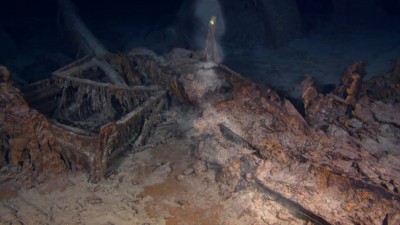
A couple interesting segments are at the RMS Titanic Archive in Atlanta, with VP of Collections Alexandra Klingelhofer. Here, objects recovered from the site are cleaned and stored. It was decided long ago to leave all objects inside the actual ship as they were, but anything found outside the ship is fair game. She shows us a number of artifacts including a coin purse and a perfume salesman's leather case with perfume samples still intact.
Finally, we have "History of the World in Two Hours" which is really the History of the World in One Hour, Twenty-Eight Minutes and Three Seconds. It looks like this was meant to be shown with commercial breaks, which gives you an idea of how much time you save by skipping them. (And I've seen some 2-hour TV productions come out even shorter than this!) Anyways, despite the inaccurate title it's pretty cool. Narrated in a dramatic tone by voice actor Corey Burton, the show doesn't really give you the history of the world as in all the historic events of humankind, but rather the scientific events that lead up to how the world is today. It starts with the Big Bang Theory, then creation of the smallest microscopic lifeforms, then discusses how those eventually evolved and became the more common animals including humans. Continental drift, where the Earth's land breaks up and shifts into the continents we know today, is depicted in animation. Once humans come into the picture, their discoveries of fire and energy sources are linked to the beginning of civilizations. One thing emphasized is that the material making up today's buildings came from elements that have already been on Earth for billions of years, and same for energy sources like coal and oil.
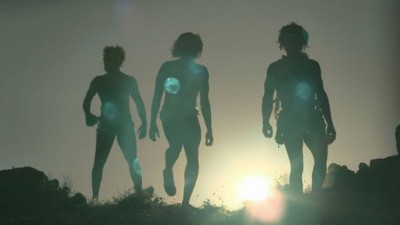
While viewing this, the term "rapid-fire" came into my mind many times, and I found only after watching that the back cover also describes this as "a rapid-fire view of history". There is a lot of fast-motion footage and quick cutting. CG-animated portions show the more scientific parts, and these are very nice-looking. Many live-action segments depicting events like early humans' discovery of fire are included and I felt these were very well-done. Some 2D stock footage is also included, which in 3D is shown as appearing slightly deeper inside the screen. Intercut are spoken segments from a number of people such as geologists and paleontologists giving their take on the subjects. They are given reasonable amounts of time to speak without being edited into sound bites.
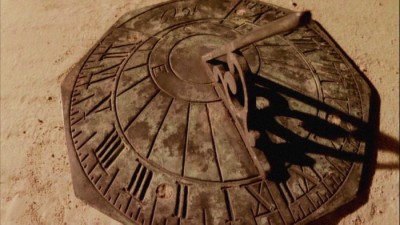
All three shows are in 1080P 3D. "World War II" and "History of the World" include the option for 2D playback as well, "Titanic" does not but it will play in 2D if your system is not set up properly for it. Overall the picture is very clean, with even footage shot decades ago looking like it has been cleaned up extensively.
As far as the 3D goes, I found it impressive on all three discs. "World War II" is essential just for the many examples of 3D done far before the 1950s Hollywood 3D movie craze. "Titanic" has many underwater shots where bubbles and floating debris give great 3D effects, and one of the speakers in this explains how the depth adds detail to the wreckage that was previously not apparent in two-dimensional pictures. It's the best view one can get without actually going down to the wreckage itself. "History of the World" is visually the best of the three. While it has no "pop-out" effects, most of the footage has incredible depth. This is certainly a great demo disc to show off 3D to any non-believers!
Sound:Despite having Dolby Digital logos on all three covers, only "Titanic" is in standard Dolby Digital 5.1 while the other two are in 5.1 DTS-HD Master Audio. "World War II" keeps sound mostly up-front with its music score and sound effects, "Titanic" does likewise with good separation of the spoken dialogue across the front three channels. "History of the World" has the best surround mix of the three, with a prominent LFE track as well.
Subtitles:Subtitles on the three discs are inconsistent. "World War II" has subtitles in English, Spanish, Dutch, German, Polish, and both simplified and traditional Mandarin. "Titanic" has English, Dutch, German, Polish, Danish, Swedish, Norwegian and Spanish. Subtitles on "History of the World" are in English, German, Spanish, Dutch and Polish.
Extras:Sadly no extras of any kind are included, not even any trailers or promos. I would have at least liked to have seen more of the unedited World War II footage.
Final Thoughts:I found all three of these discs both educational and entertaining. They may lose some appeal when viewed in 2D, but if you're equipped for 3D I highly recommend them. "World War II in 3D" is especially recommended for anyone interested in the history of 3D photography in general.
Pictures in this review were not taken directly from the Blu-Ray discs.
Jesse Skeen is a life-long obsessive media collector (with an unhealthy preoccupation with obsolete and failed formats) and former theater film projectionist. He enjoys watching movies and strives for presenting them perfectly, but lacks the talent to make his own.
|
| Popular Reviews |
| Sponsored Links |
|
|
| Sponsored Links |
|
|
| Release List | Reviews | Shop | Newsletter | Forum | DVD Giveaways | Blu-Ray | Advertise |
|
Copyright 2024 DVDTalk.com All Rights Reserved. Legal Info, Privacy Policy, Terms of Use,
Manage Preferences,
Your Privacy Choices | |||||||













